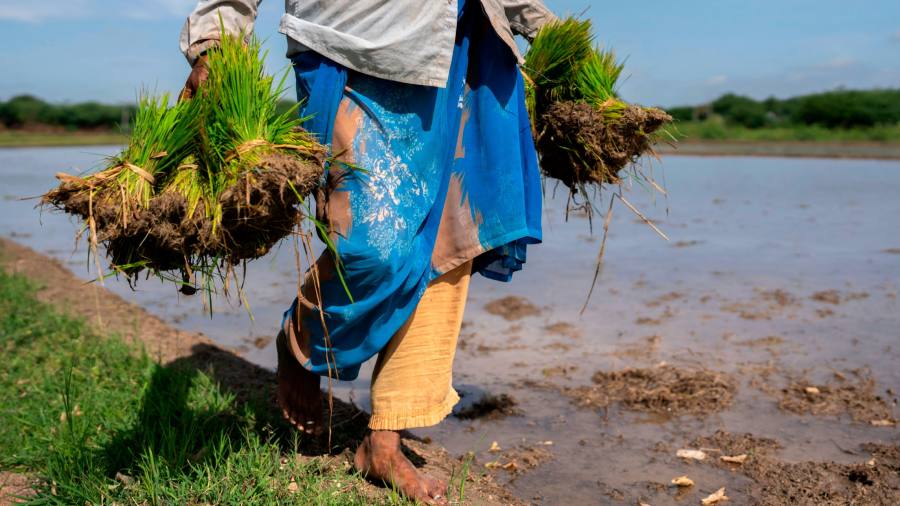Receive free Food Prices updates
We’ll send you a myFT Daily Digest email rounding up the latest Food Prices news every morning.
This year’s El Niño weather event is expected to compound the effects on global food prices of India’s rice export ban and Russia’s withdrawal from the Black Sea grain deal, potentially stoking inflation across emerging markets.
Starting in September, the natural temperature fluctuation in the Pacific Ocean known as El Niño is forecast to bring months of extreme heat to parts of South Asia and Central America, as well as heavy rainfall over the Andes.
The phenomenon typically disrupts crop cycles and is likely to add further strain to global food output and prices after heavy rainfall forced India to ban exports of non-basmati white rice and Russia bombarded Ukrainian grain terminals.
Combined, the three shocks could boost household inflation expectations in poorer countries where food typically comprises around 30 per cent of typical spending on consumer goods and services — double the figure for developed economies.
That spillover could increase pressure on emerging market central banks to keep interest rates higher for longer, sparking volatility in local equity and sovereign bond markets priced for rate cuts later this year.
However, “complacent” investors have yet to price in how the spell of extreme weather will influence commodity and financial markets, said Zanna Aleksahhina, grains analyst at commodities research group Mintec.
“We’re looking at weather forecasts two-to-six weeks ahead like mad, they’re going to be crucial. But the market doesn’t want to factor in any sort of risk premium just yet,” she said.
The moves by India and Russia are already beginning to be seen in global food prices. The United Nations’ FAO food price index fell 26 per cent between March 2022 and June but rose 1.3 per cent in July, as vegetable oil prices jumped 12.1 per cent. International wheat prices rose 1.6 per cent, their first month-on-month increase since December, while the FAO All Rice Price Index increased 2.8 per cent to its highest level since September 2011.
Global benchmark cocoa futures have risen to around $3,500 per tonne, up from $2,400 a year ago to the highest level since 2011. “El Niño increases the risk for the crop in the year ahead,” said Jonathan Haines, senior research analyst at Gro-Intelligence.
“El Niño tends to peak in November to February, but implications for food inflation, fiscal budgets, monetary policy, [gross domestic product], and trade, particularly in emerging markets, last longer,” said Laura Sanchez, head of sustainability equity research for the Americas at Morgan Stanley.
Faced with a strong El Niño, “emerging market central banks would need to keep policy rates higher for longer to combat more persistent inflation,” said Diana Iovanel, markets economist at Capital Economics.
That would raise government borrowing costs at a time when investors are discounting multiple rate cuts, she added.
In June, Shaktikanta Das, governor of the Reserve Bank of India, said there were “concerns” around drier weather caused by El Niño later this year. Two days later, Thailand’s monetary policy committee flagged a potential hit to raw food prices.
“Uncertainty about the impact of the El Niño phenomenon stands out” as a key headwind for falling domestic food prices, according to the Banco Central do Brasil, which earlier this month followed Chile in lowering rates for the first time since the pandemic.
Expect higher demand for fertiliser, pesticides and genetically modified seeds, said Ehiwario Efeyini, senior market strategy analyst at BofA. “Equities along the agribusiness supply chain, including machinery, chemicals and processing, also stand to be beneficiaries,” he added.
However, the impact on global inflation from “a large El Niño could spread beyond just food”, according to JPMorgan. The bank’s analysis of a World Bank data set of commodity prices stretching back to the 1960s found that El Niño events — which typically occur twice a decade — correlate with higher global prices for rubber, timber and zinc.
In Australia, El Niño tends to bring heavy rainfall to the western Pilbara region, home to vast reserves of iron ore. Australia accounts for roughly 60 per cent of the seaborne iron ore market, meaning higher prices in the event of weather-induced disruptions.
Developed markets are unlikely to escape scot-free. Parts of Central America where El Niño is expected to bring extreme heat are already contending with a drought so severe that authorities at the Panama Canal — whose system of locks and reservoirs relies on the availability of freshwater — have been forced to cut the number of daily crossings.
Demand for the liquefied natural gas being carried on tankers waiting on either side of the trade route would inevitably increase if El Niño causes a colder winter in Europe, as it has in the past.
“We are now in a world fraught with risks, and higher prices”, said Joe DeLaura, senior energy strategist at Rabobank.
“We are facing a world where the Rhine depth at Kaub, Panama Canal transit numbers and reservoir stockpiles will be monitored as closely as the [US Energy Information Administration’s] petroleum reports every week.”
Read the full article here



